Bacterial and Fungal Keratitis in a Tertiary Care Hospital from Romania
Abstract
:1. Introduction
2. Material and Methods
2.1. Microbiological Analysis
2.2. Antifungal Susceptibility Testing
2.3. Statistical Analysis
3. Results
3.1. Etiology of Bacterial and Fungal Keratitis and Antimicrobial Resistance
3.2. Antimicrobial Resistance of the Isolated Microorganisms
3.3. Resistance to Antifungals
3.4. Analysis of Risk Factors for Bacterial and Fungal Keratitis
3.5. Clinical Evolution of the Patients
4. Discussion
4.1. Etiology of Bacterial and Fungal Keratitis and Antimicrobial Resistance
4.2. Antimicrobial Resistance of the Isolated Microorganisms
4.3. Resistance to Antifungals
4.4. Analysis of Risk Factors for Bacterial and Fungal Keratitis
4.5. Clinical Evolution of the Patients
5. Conclusions
Author Contributions
Funding
Data Availability Statement
Conflicts of Interest
References
- Dolan, P.; Laffan, K.; Kudrna, L. The Welleye: A Conceptual Framework for Understanding and Promoting Wellbeing. Front. Psychol. 2021, 12, 716572. [Google Scholar] [CrossRef] [PubMed]
- Ravilla, T.; Karumanchi, S.; Das, T. Health Management and Information: Key Principles and Enablers in Eye Health Program. In South-East Asia Eye Health; Springer: Singapore, 2021; pp. 23–50. [Google Scholar] [CrossRef]
- Burton, M.J.; Ramke, J.; Marques, A.P.; Bourne, R.R.A.; Congdon, N.; Jones, I.; Ah Tong, B.A.M.; Arunga, S.; Bachani, D.; Bascaran, C.; et al. The Lancet Global Health Commission on Global Eye Health: Vision beyond 2020. Lancet Glob. Health 2021, 9, e489–e551. [Google Scholar] [CrossRef] [PubMed]
- Assi, L.; Rosman, L.; Chamseddine, F.; Ibrahim, P.; Sabbagh, H.; Congdon, N.; Evans, J.; Ramke, J.; Kuper, H.; Burton, M.J.; et al. Eye Health and Quality of Life: An Umbrella Review Protocol. BMJ Open 2020, 10, e037648. [Google Scholar] [CrossRef] [PubMed]
- Martines, E.; Reitberger, H.; Chow, C.; Brun, P.; Zuin, M.; Fuchsluger, T.A. Perspectives in Ophthalmology. In Comprehensive Clinical Plasma Medicine: Cold Physical Plasma for Medical Application; Springer: Berlin/Heidelberg, Germany, 2018; pp. 421–430. [Google Scholar] [CrossRef]
- Sereda, D.; Nieścior, H.; Metelska, A.; Metelski, J.; Szwed, M. Risk Factors for Infectious Keratitis—A Literature Review. J. Educ. Health Sport 2022, 12, 450–465. [Google Scholar] [CrossRef]
- Stapleton, F. The Epidemiology of Infectious Keratitis. Ocul. Surf. 2023, 28, 351–363. [Google Scholar] [CrossRef] [PubMed]
- Ting, D.S.J.; Ho, C.S.; Deshmukh, R.; Said, D.G.; Dua, H.S. Infectious Keratitis: An Update on Epidemiology, Causative Microorganisms, Risk Factors, and Antimicrobial Resistance. Eye 2021, 35, 1084–1101. [Google Scholar] [CrossRef]
- Ung, L.; Chodosh, J. Urgent Unmet Needs in the Care of Bacterial Keratitis: An Evidence-Based Synthesis. Ocul. Surf. 2023, 28, 378–400. [Google Scholar] [CrossRef]
- Pramanick, P.; Sengupta, M.; Banerjee, M.; Ghosh, S.; Mitra, A.N.; Chakraborty, M.; Sengupta, M. Microbiological Profile in Patients Having Keratitis in a Tertiary Care Hospital in India. Cureus 2022, 14, e31653. [Google Scholar] [CrossRef]
- Dunster, E.; Johnson, W.L.; Wozniak, R.A.F. Antimicrobial Drug-Drug Interactions in the Treatment of Infectious Keratitis. Cornea 2023, 42, 1555–1561. [Google Scholar] [CrossRef] [PubMed]
- Suzuki, T.; Inoue, H. Mechanisms Underlying Contact Lens-Related Keratitis Caused by Pseudomonas Aeruginosa. Eye Contact Lens 2022, 48, 134–137. [Google Scholar] [CrossRef]
- Badenoch, P.R. A Turning Point for Contact Lens-Associated Microbial Keratitis? Clin. Exp. Ophthalmol. 2019, 47, 701–703. [Google Scholar] [CrossRef] [PubMed]
- Bakken, I.M.; Jackson, C.J.; Utheim, T.P.; Villani, E.; Hamrah, P.; Kheirkhah, A.; Nielsen, E.; Hau, S.; Lagali, N.S. The Use of in Vivo Confocal Microscopy in Fungal Keratitis—Progress and Challenges. Ocul. Surf. 2022, 24, 103–118. [Google Scholar] [CrossRef] [PubMed]
- Borroni, D.; Bonzano, C.; Sánchez-González, J.M.; Rachwani-Anil, R.; Zamorano-Martín, F.; Pereza-Nieves, J.; Traverso, C.E.; García Lorente, M.; Rodríguez-Calvo-de-Mora, M.; Esposito, A.; et al. Shotgun Metagenomic Sequencing in Culture Negative Microbial Keratitis. Eur. J. Ophthalmol. 2023, 33, 1589–1595. [Google Scholar] [CrossRef] [PubMed]
- Winiarczyk, M.; Biela, K.; Michalak, K.; Winiarczyk, D.; Mackiewicz, J. Changes in Tear Proteomic Profile in Ocular Diseases. Int. J. Environ. Res. Public. Health 2022, 19, 13341. [Google Scholar] [CrossRef]
- Eby, A.; Hazlett, L.; Microb, J.; Technol, B. Pseudomonas Keratitis, a Review of Where Wehave Been and What Lies. J. Microb. Biochem. Technol. 2015, 8, 9–13. [Google Scholar] [CrossRef]
- Gao, N.; Kumar, A.; Yu, F.S.X. Matrix Metalloproteinase-13 as a Target for Suppressing Corneal Ulceration Caused by Pseudomonas Aeruginosa Infection. J. Infect. Dis. 2015, 212, 116–127. [Google Scholar] [CrossRef] [PubMed]
- Wu, J.; Yuan, Z.; Fang, Z.; Huang, Z.; Xu, Y.; Xie, W.; Wu, F.; Yao, Y.F. A Knowledge-Enhanced Transform-Based Multimodal Classifier for Microbial Keratitis Identification. Sci. Rep. 2023, 13, 9003. [Google Scholar] [CrossRef]
- Mayya, V.; Shevgoor, S.K.; Kulkarni, U.; Hazarika, M.; Barua, P.D.; Acharya, U.R. Multi-Scale Convolutional Neural Network for Accurate Corneal Segmentation in Early Detection of Fungal Keratitis. J. Fungi 2021, 7, 850. [Google Scholar] [CrossRef] [PubMed]
- Tuft, S.; Bunce, C.; De, S.; Thomas, J. Utility of Investigation for Suspected Microbial Keratitis: A Diagnostic Accuracy Study. Eye 2023, 37, 415–420. [Google Scholar] [CrossRef]
- Üçkayabaşi, A.; Kandemİr, T.; Nağiyev, T. Investigation of the Presence of Mycobacteria along with Microbial Agents in Cases of Keratitis. Turk. Bull. Hyg. Exp. Biol. 2022, 79, 509–522. [Google Scholar] [CrossRef]
- Badreldin, I.; Justesen, B.; Lyhne, N.; Fuursted, K.; Vestergaard, A.H.; Justesen, U.S. Identification of Microorganisms in Patients with Keratitis by Next-Generation Sequencing. Acta Ophthalmol. 2023, 101, 353–354. [Google Scholar] [CrossRef]
- Herrmann, W.; Kohnen, T. Bacterial Keratitis. In Encyclopedia of Ophthalmology; Erfurth, U., Kohnen, T., Eds.; Springer: Berlin, Heidelberg, 2018. [Google Scholar] [CrossRef]
- Shilovskikh, O.V.; Ponomarev, V.O.; Kazaykin, V.N.; Tkachenko, K.A. Bacterial Keratitis. Part 2. Topical Aspects of Treatment. Oftalmologiya 2023, 20, 24–32. [Google Scholar] [CrossRef]
- Sarkar, T.; Singh, M.; Kumar Jana, B.; Mazumder, B. Current Formulation Strategies to Design Novel Carriers for Targeted Drug Delivery and Management of Infectious Keratitis: A Comprehensive Review on the Present State of the Art. Lett. Drug Des. Discov. 2023, 20, 1–23. [Google Scholar] [CrossRef]
- Onkar, A. Commentary: Tackling Childhood Infectious Keratitis. Indian J. Ophthalmol. 2023, 71, 846–847. [Google Scholar] [CrossRef] [PubMed]
- Mahmoudi, S.; Masoomi, A.; Ahmadikia, K.; Tabatabaei, S.A.; Soleimani, M.; Rezaie, S.; Ghahvechian, H.; Banafsheafshan, A. Fungal Keratitis: An Overview of Clinical and Laboratory Aspects. Mycoses 2018, 61, 916–930. [Google Scholar] [CrossRef] [PubMed]
- Ansari, Z.; Miller, D.; Galor, A. Current Thoughts in Fungal Keratitis: Diagnosis and Treatment. Curr. Fungal Infect. Rep. 2013, 7, 209–218. [Google Scholar] [CrossRef] [PubMed]
- Holz, F.G.; Tadayoni, R.; Beatty, S.; Berger, A.; Cereda, M.G.; Hykin, P.; Staurenghi, G.; Wittrup-Jensen, K.; Altemark, A.; Nilsson, J.; et al. Key Drivers of Visual Acuity Gains in Neovascular Age-Related Macular Degeneration in Real Life: Findings from the AURA Study. Br. J. Ophthalmol. 2016, 100, 1623–1628. [Google Scholar] [CrossRef]
- Jin, W.Y.; Jang, S.J.; Lee, M.J.; Park, G.; Kim, M.J.; Kook, J.K.; Kim, D.M.; Moon, D.S.; Park, Y.J. Evaluation of VITEK 2, MicroScan, and Phoenix for Identification of Clinical Isolates and Reference Strains. Diagn. Microbiol. Infect. Dis. 2011, 70, 442–447. [Google Scholar] [CrossRef]
- Clinical & Laboratory Standards Institute. CLSI M38: Reference Method for Broth Dilution Antifungal Susceptibility Testing of Filamentous Fungi, 3rd ed.; CLSI: Denver, CO, USA, 2017. [Google Scholar]
- Alastruey-Izquierdo, A.; Cuenca-Estrella, M.; Monzón, A.; Mellado, E.; Rodríguez-Tudela, J.L. Antifungal Susceptibility Profile of Clinical Fusarium spp. Isolates Identified by Molecular Methods. J. Antimicrob. Chemother. 2008, 61, 805–809. [Google Scholar] [CrossRef]
- Lakhundi, S.; Siddiqui, R.; Khan, N.A. Pathogenesis of Microbial Keratitis. Microb. Pathog. 2017, 104, 97–109. [Google Scholar] [CrossRef]
- Chang, V.S.; Dhaliwal, D.K.; Raju, L.; Kowalski, R.P. Antibiotic Resistance in the Treatment of Staphylococcus Aureus Keratitis: A 20-Year Review. Cornea 2015, 34, 698–703. [Google Scholar] [CrossRef] [PubMed]
- Peng, M.Y.; Cevallos, V.; McLeod, S.D.; Lietman, T.M.; Rose-Nussbaumer, J. Bacterial Keratitis: Isolated Organisms and Antibiotic Resistance Patterns in San Francisco. Cornea 2018, 37, 84–87. [Google Scholar] [CrossRef]
- Liu, H.Y.; Chu, H.S.; Wang, I.J.; Chen, W.L.; Hu, F.R. Microbial Keratitis in Taiwan: A 20-Year Update. Am. J. Ophthalmol. 2019, 205, 74–81. [Google Scholar] [CrossRef] [PubMed]
- Ghenea, A.E.; Cioboată, R.; Drocaş, A.I.; Țieranu, E.N.; Vasile, C.M.; Moroşanu, A.; Țieranu, C.G.; Salan, A.I.; Popescu, M.; Turculeanu, A.; et al. Prevalence and Antimicrobial Resistance of Klebsiella Strains Isolated from a County Hospital in Romania. Antibiotics 2021, 10, 868. [Google Scholar] [CrossRef] [PubMed]
- Ghenea, A.E.; Zlatian, O.M.; Cristea, O.M.; Ungureanu, A.; Mititelu, R.R.; Balasoiu, A.T.; Vasile, C.M.; Salan, A.-I.; Iliuta, D.; Popescu, M.; et al. TEM,CTX-M,SHV Genes in ESBL-Producing Escherichia Coli and Klebsiella Pneumoniae Isolated from Clinical Samples in a County Clinical Emergency Hospital Romania-Predominance of CTX-M-15. Antibiotics 2022, 11, 503. [Google Scholar] [CrossRef] [PubMed]
- Bucataru, A.; Balasoiu, M.; Ghenea, A.E.; Zlatian, O.M.; Vulcanescu, D.D.; Horhat, F.G.; Bagiu, I.C.; Sorop, V.B.; Sorop, M.I.; Oprisoni, A.; et al. Factors Contributing to Surgical Site Infections: A Comprehensive Systematic Review of Etiology and Risk Factors. Clin. Pract. 2023, 14, 52–68. [Google Scholar] [CrossRef] [PubMed]
- Vazirani, J.; Wurity, S.; Ali, M.H. Multidrug-Resistant Pseudomonas Aeruginosa Keratitis: Risk Factors, Clinical Characteristics, and Outcomes. Ophthalmology 2015, 122, 2110–2114. [Google Scholar] [CrossRef]
- Barker, N.H.; Thompson, J.M.; Mullen, M.G.; Weekes, M.A.; Nguyen, L.N.; Haynes, C.K.M.; Miller, D. Rhizobium Radiobacter: A Recently Recognized Cause of Bacterial Keratitis. Cornea 2016, 35, 679–682. [Google Scholar] [CrossRef] [PubMed]
- Balasoiu, A.T.; Zlatian, O.M.; Ghenea, A.E.; Davidescu, L.; Lungu, A.; Golli, A.L.; Udriștoiu, A.L.; Balasoiu, M. A Rare Case of Endophthalmitis with Rhizobium Radiobacter, Soon after a Resolved Keratitis: Case Report. Antibiotics 2022, 11, 905. [Google Scholar] [CrossRef]
- Fenner, B.J.; Kumar, A.; Tan, N.Y.Q.; Ang, M. Case of Isolated Rhizobium Radiobacter Contact Lens-Related Infectious Keratitis: A Plant Microbe Now Emerging as a Human Pathogen. Am. J. Ophthalmol. Case Rep. 2019, 15, 100476. [Google Scholar] [CrossRef]
- Rondeau, N.; Bourcier, T.; Chaumeil, C.; Borderie, V.; Touzeau, O.; Scat, Y.; Thomas, F.; Baudouin, C.; Nordmann, J.-P.; Laroche, L. Fungal Keratitis at the Centre Hospitalier National d’Ophtalmologie Des Quinze-Vingts: Retrospective Study of 19 Cases. J. Fr. Ophtalmol. 2002, 25, 890–896. [Google Scholar]
- Xie, L.; Zhai, H.; Zhao, J.; Sun, S.; Shi, W.; Dong, X. Antifungal Susceptibility for Common Pathogens of Fungal Keratitis in Shandong Province, China. Am. J. Ophthalmol. 2008, 146, 260–265.e1. [Google Scholar] [CrossRef]
- Dóczi, I.; Gyetvai, T.; Kredics, L.; Nagy, E. Involvement of Fusarium spp. in Fungal Keratitis. Clin. Microbiol. Infect. 2004, 10, 773–776. [Google Scholar] [CrossRef]
- Egrilmez, S.; Yildirim-Theveny, Ş. Treatment-Resistant Bacterial Keratitis: Challenges and Solutions. Clin. Ophthalmol. 2020, 14, 287–297. [Google Scholar] [CrossRef] [PubMed]
- Thomas, R.K.; Melton, R.; Asbell, P.A. Antibiotic Resistance among Ocular Pathogens: Current Trends from the ARMOR Surveillance Study (2009–2016). Clin. Optom. 2019, 11, 15–26. [Google Scholar] [CrossRef] [PubMed]
- Lin, A.; Rhee, M.K.; Akpek, E.K.; Amescua, G.; Farid, M.; Garcia-Ferrer, F.J.; Varu, D.M.; Musch, D.C.; Dunn, S.P.; Mah, F.S. Bacterial Keratitis Preferred Practice Pattern®. Ophthalmology 2019, 126, P1–P55. [Google Scholar] [CrossRef]
- Constantinou, M.; Daniell, M.; Snibson, G.R.; Vu, H.T.; Taylor, H.R. Clinical Efficacy of Moxifloxacin in the Treatment of Bacterial Keratitis. A Randomized Clinical Trial. Ophthalmology 2007, 114, 1622–1629. [Google Scholar] [CrossRef]
- Oldenburg, C.E.; Lalitha, P.; Srinivasan, M.; Manikandan, P.; Jayahar Bharathi, M.; Rajaraman, R.; Ravindran, M.; Mascarenhas, J.; Nardone, N.; Ray, K.J.; et al. Moxifloxacin Susceptibility Mediates the Relationship between Causative Organism and Clinical Outcome in Bacterial Keratitis. Investig. Ophthalmol. Vis. Sci. 2013, 54, 1522–1526. [Google Scholar] [CrossRef] [PubMed]
- Dave, T.V.; Dave, V.P.; Sharma, S.; Karolia, R.; Joseph, J.; Pathengay, A.; Pappuru, R.R.; Das, T. Infectious Endophthalmitis Leading to Evisceration: Spectrum of Bacterial and Fungal Pathogens and Antibacterial Susceptibility Profile. J. Ophthalmic Inflamm. Infect. 2019, 9, 9. [Google Scholar] [CrossRef]
- Shigeyasu, C.; Yamada, M.; Nakamura, N.; Mizuno, Y.; Sato, T.; Yaguchi, T. Keratomycosis Caused by Aspergillus Viridinutans: An Aspergillus Fumigatus-Resembling Mold Presenting Distinct Clinical and Antifungal Susceptibility Patterns. Med. Mycol. 2012, 50, 525–528. [Google Scholar] [CrossRef]
- Alastruey-izquierdo, A.; Cuesta, I.; Ros, L.; Mellado, E.; Rodriguez-tudela, J.L. Antifungal Susceptibility Profile of Clinical Alternaria spp. Identified by Molecular Methods. J. Antimicrob. Chemother. 2011, 66, 2585–2587. [Google Scholar] [CrossRef] [PubMed]
- da Cunha, K.C.; Sutton, D.A.; Fothergill, A.W.; Gené, J.; Cano, J.; Madrid, H.; de Hoog, S.; Crous, P.W.; Guarro, J. In Vitro Antifungal Susceptibility and Molecular Identity of 99 Clinical Isolates of the Opportunistic Fungal Genus Curvularia. Diagn. Microbiol. Infect. Dis. 2013, 76, 168–174. [Google Scholar] [CrossRef] [PubMed]
- Cannon, R.D.; Lamping, E.; Holmes, A.R.; Niimi, K.; Baret, P.V.; Keniya, M.V.; Tanabe, K.; Niimi, M.; Goffeau, A.; Monk, B.C. Efflux-Mediated Antifungal Drug Resistance. Clin. Microbiol. Rev. 2009, 22, 291–321. [Google Scholar] [CrossRef] [PubMed]
- Bourcier, T.; Thomas, F.; Borderie, V.; Chaumeil, C.; Laroche, L. Bacterial Keratitis: Predisposing Factors, Clinical and Microbiological Review of 300 Cases. Br. J. Ophthalmol. 2003, 87, 834–838. [Google Scholar] [CrossRef] [PubMed]
- Bharathi, M.J.; Ramakrishnan, R.; Meenakshi, R.; Shivakumar, C.; Raj, D.L. Analysis of the Risk Factors Predisposing to Fungal, Bacterial & Acanthamoeba Keratitis in South India. Indian J. Med. Res. 2009, 130, 749–757. [Google Scholar] [PubMed]
- Liesegang, T.J. Contact Lens-Related Microbial Keratitis: Part I: Epidemiology. Cornea 1997, 16, 125–131. [Google Scholar] [CrossRef] [PubMed]
- Kolar, S.S.N.; Luca, V.; Baidouri, H.; Mannino, G.; McDermott, A.M.; Mangoni, M.L. Esculentin-1a(1-21)NH2: A Frog Skin-Derived Peptide for Microbial Keratitis. Cell. Mol. Life Sci. 2015, 72, 617–627. [Google Scholar] [CrossRef]
- Groves, J.S.; Smail, J.M. Outbreak of Superficial Keratitis in Rubber Workers. Br. J. Ophthalmol. 1969, 53, 683–687. [Google Scholar] [CrossRef]
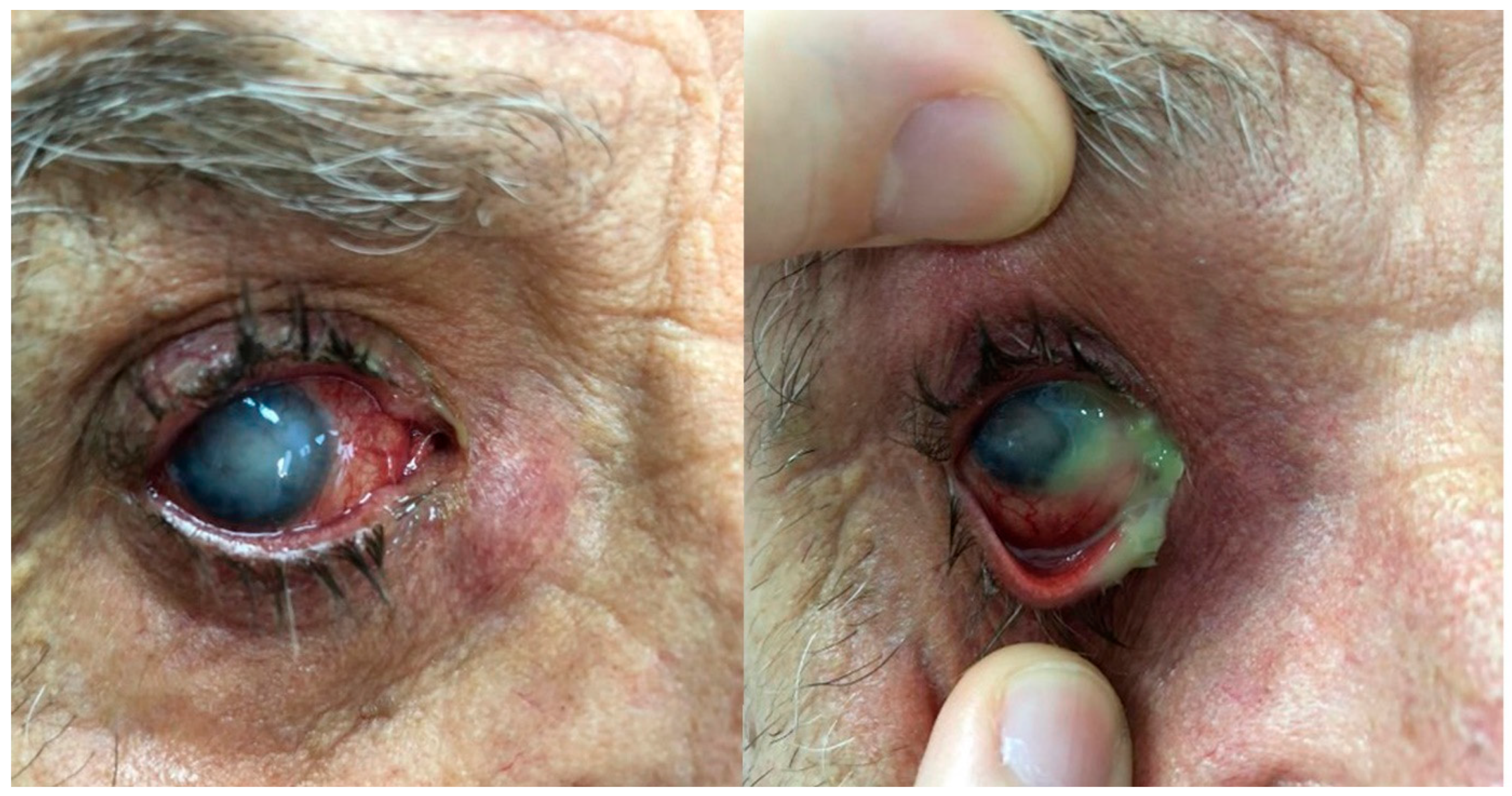
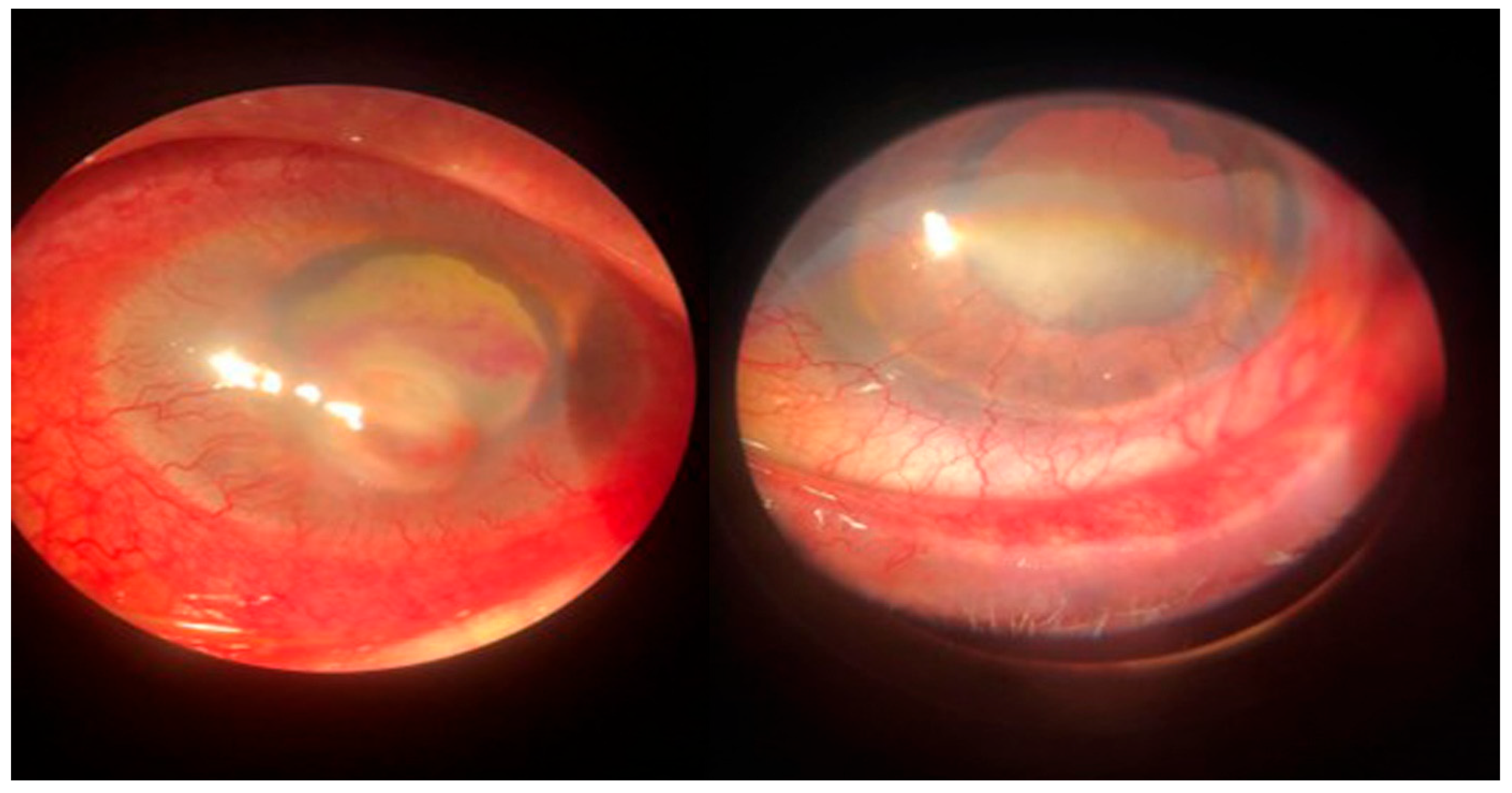
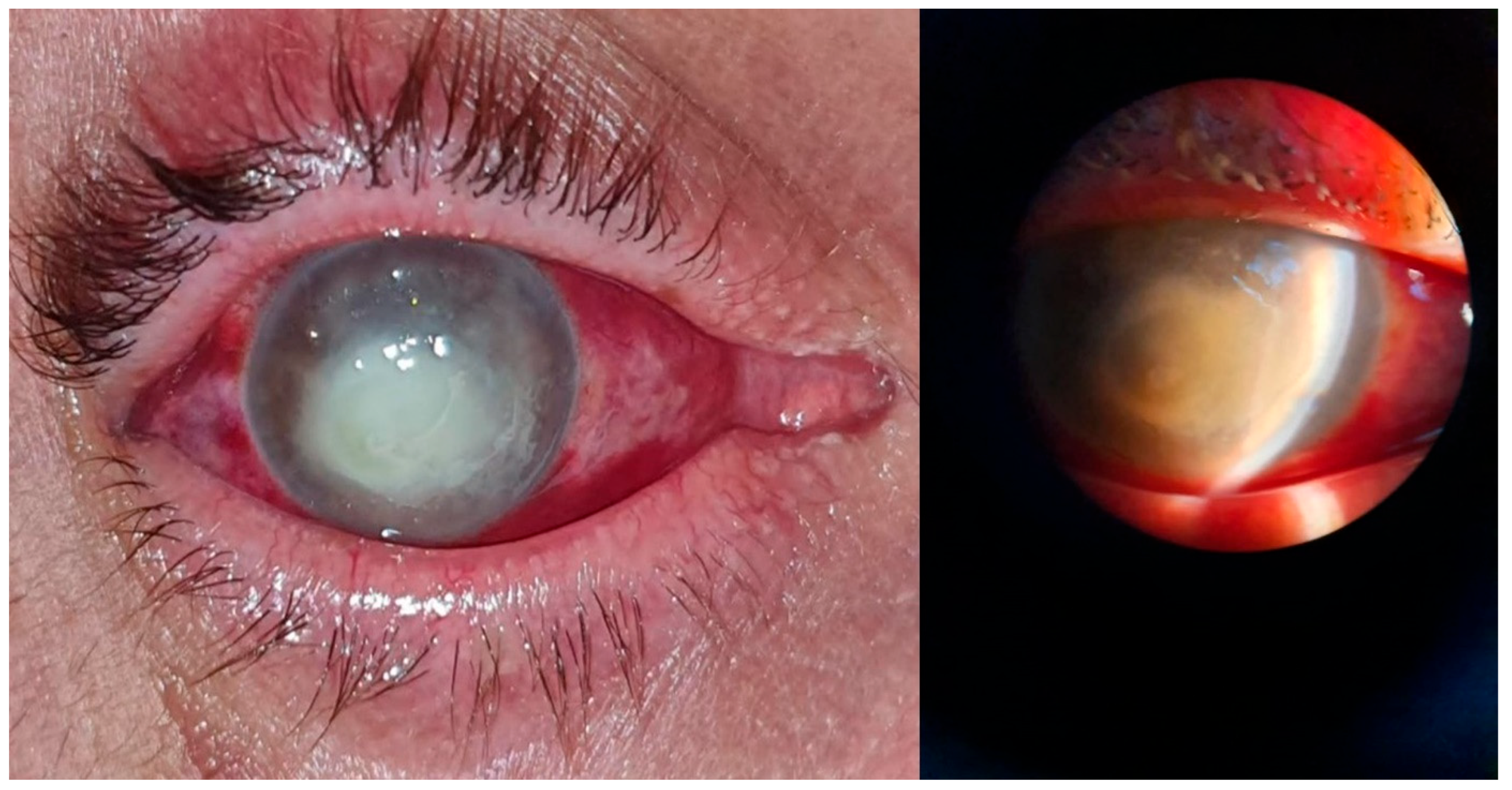
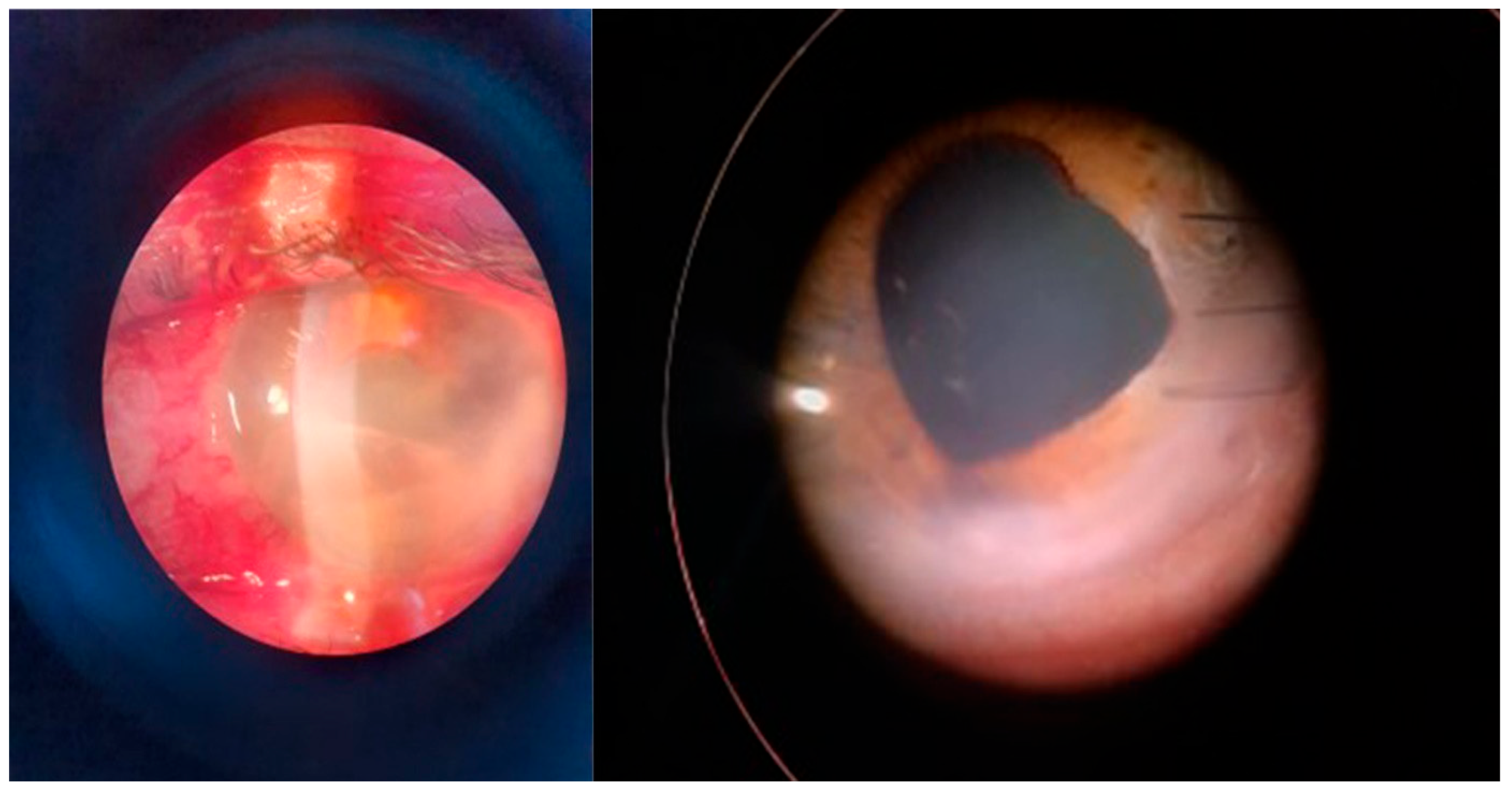

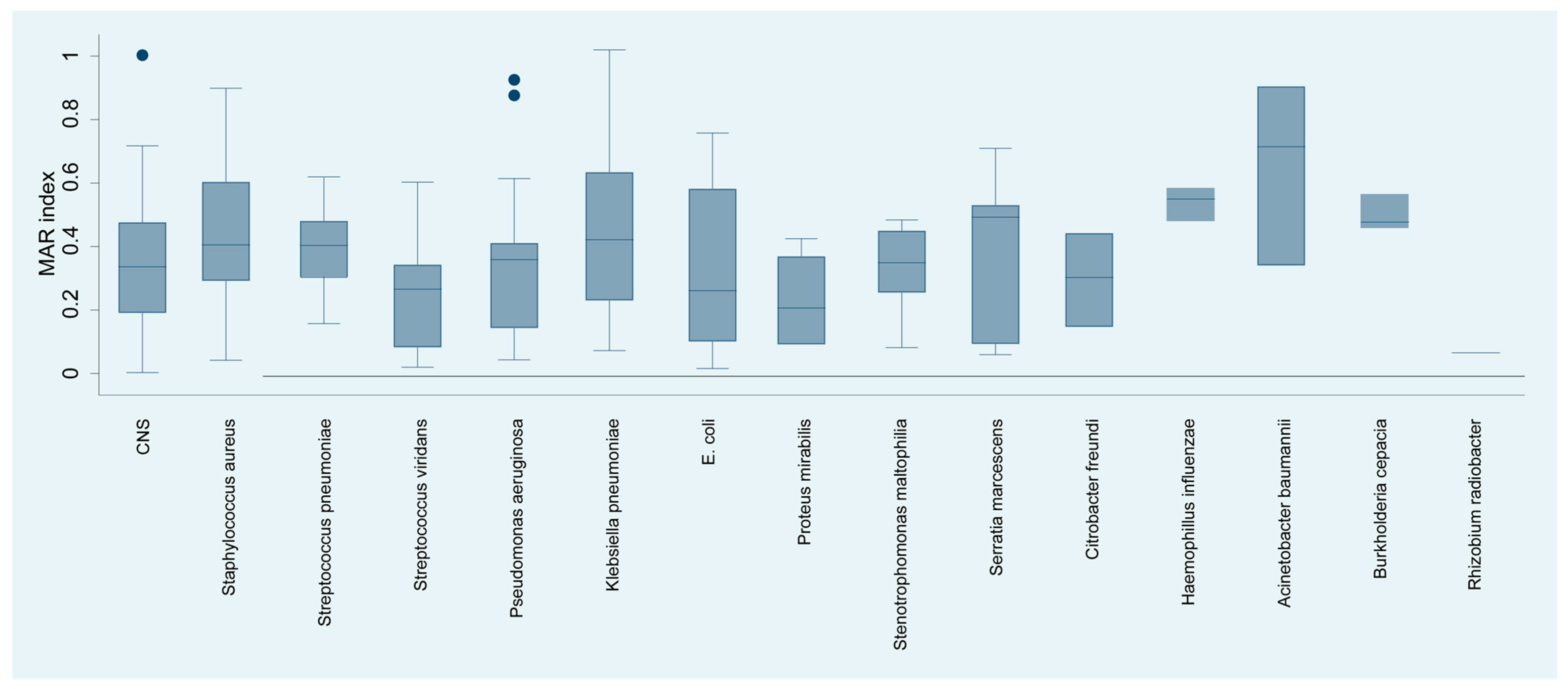
| Species | No. | % |
|---|---|---|
| Gram-positives | ||
| CNS | 80 | 35.40% |
| Staphylococcus aureus | 25 | 11.06% |
| Streptococcus pneumoniae | 16 | 7.08% |
| Streptococcus viridans | 8 | 3.54% |
| Gram-negatives | ||
| Pseudomonas aeruginosa | 32 | 14.16% |
| Klebsiella pneumoniae | 18 | 7.96% |
| Escherichia coli | 6 | 2.65% |
| Proteus mirabilis | 6 | 2.65% |
| Stenotrophomonas maltophilia | 4 | 1.77% |
| Serratia marcescens | 4 | 1.77% |
| Citrobacter freundi | 3 | 1.33% |
| Haemophyllus influenzae | 3 | 1.33% |
| Acinetobacter baumannii | 2 | 0.88% |
| Burkholderia cepacia | 2 | 0.88% |
| Rhizobium radiobacter | 1 | 0.44% |
| Fungi | ||
| Fusarium solani | 6 | 2.65% |
| Candida albicans | 5 | 2.21% |
| Aspergillus spp. | 2 | 0.88% |
| Curvularia lunata | 2 | 0.88% |
| Alternaria alternata | 1 | 0.44% |
| Total | 226 | 100.00% |
| Staph. Aureus (Cards GP67, P592) | Streptococcus sp. (Card ST-03) | CNS (Cards GP67, P592) | Streptococcus pneumoniae (Card P576) | |
|---|---|---|---|---|
| Amoxicillin | - | 0.00% | - | 68.75% |
| Ampicillin | - | 0.00% | - | - |
| Chloramphenicol | - | - | - | 6.25% |
| Ciprofloxacin | 33.90% | - | 24.14% | - |
| Clindamycin | 40.00% | 33.33% | 33.90% | - |
| Ceftriaxone | - | 8.53% | - | 12.50% |
| Cefotaxime | - | 8.53% | - | 6.25% |
| Doxicycline | - | - | - | - |
| Erythromycin | 70.49% | 33.33% | 49.12% | 43.75% |
| Cefoxitin | 32.20% | - | 12.28%% | - |
| Gentamycin | 43.55% | - | 41.07% | - |
| Gentamycin HL | - | 0.00% | - | - |
| Imipenem | - | - | - | 12.50% |
| Linezolid | 3.51% | 25.00% | 3.64% | 6.25% |
| Levofloxacin | 20.00% | 0.00% | 13.64% | 31.25% |
| Moxifloxacin | 16.39% | 0.00% | 11.86% | 12.50% |
| Ofloxacin | - | - | - | 37.50% |
| Oxacillin | 32.20% | 75.00% | 12.28% | - |
| Benzyl-Penicillin | 80.65% | 16.67% | 77.97% | 81.25% |
| Quinupristin/Daptomycin | - | 0.00% | - | - |
| Rifampin | 9.84% | - | 15.25% | - |
| Sparfloxacin | - | - | - | 12.50% |
| Sulfametoxazole/Trimethoprime | - | - | - | 75.00% |
| Telitromycin | - | - | - | 18.75% |
| Tetracycline | 66.10% | 16.67% | 63.79% | 43.75% |
| Tigecylcine | 43.48% | 0.00% | 15.00% | - |
| Vancomycin | 0.00% | 50.00% | 0.00% | 6.25% |
| E. coli | Klebsiella pneumoniae | Citrobacter spp. | Proteus spp. | Pseudomonas aeruginosa | |
|---|---|---|---|---|---|
| Amikacin | 0.00% | 21.20% | 0.00% | 0.00% | 17.65% |
| Amoxicillin-clavulanic acid | 33.33% | 76.92% | 100.00% | 25.00% | 66.67% |
| Ampicillin | 75.00% | 100.00% | 100.00% | 50.00% | - |
| Aztreonam | 40.00% | 33.33% | 33.33% | 0.00% | 22.22% |
| Cefuroxime | 25.00% | 53.85% | 0.00% | 0.00% | 55.56% |
| Cefalotine | - | - | - | - | - |
| Cefixime | - | - | - | - | - |
| Cefpirome | 25.00% | 50.00% | 50.00% | 0.00% | 40.00% |
| Ceftazidime | 20.00% | 35.71% | 0.00% | 25.00% | 20.00% |
| Ceftazidime-avibactam | - | - | - | - | - |
| Ceftolozane-tazobactam | - | - | - | - | - |
| Cefotaxime | 0.00% | 30.77% | 50.00% | 0.00% | - |
| Gentamycin | 25.00% | 54.55% | 0.00% | 16.67% | 58.33% |
| Tobramycin | 25.00% | 53.85% | 50.00% | 33.33% | 27.78% |
| Ciprofloxacin | 16.67% | 23.53% | 50.00% | 0.00% | 29.41% |
| Levofloxacin | 0.00% | 0.00% | 0.00% | 0.00% | - |
| Moxifloxacin | 50.00% | 37.50% | 0.00% | 0.00% | 0.00% |
| Ofloxacin | 100.00% | 14.29% | 50.00% | 0.00% | 0.00% |
| Imipenem | 20.00% | 28.57% | 33.33% | 50.00% | 22.22% |
| Ertapenem | 0.00% | 31.25% | 0.00% | 0.00% | 41.67% |
| Meropenem | 0.00% | 50.00% | 0.00% | 0.00% | 16.67% |
| Piperacillin | |||||
| Piperacillin-tazobactam | 33.33% | 14.29% | 0.00% | 0.00% | 6.67% |
| Sulfametoxazole-trimethoprim | 75.00% | 33.33% | 0.00% | 0.00% | 81.82% |
| Colistin | 0.00% | 7.69% | 33.33% | 66.67% | 0.00% |
| Tetracycline | 100.00% | 100.00% | 100.00% | 50.00% | - |
| Chloramphenicol | 0.00% | 25.00% | 50.00% | 33.33% | - |
| Tigecycline | 0.00% | 41.67% | 66.67% | 25.00% | 25.00% |
| Species | AMB | ECO | MCZ | FLU | ITR | FCY | NYS | CAS | VOR | POS | ISA | TEB |
|---|---|---|---|---|---|---|---|---|---|---|---|---|
| Fusarium solani | 1 | 64 | 32 | 64 | 64 | 64 | 64 | 16 | 64 | 64 | 64 | 64 |
| Candida albicans | 1 | 2 | 1 | 4 | 2 | 4 | 32 | 1 | 4 | 2 | 1 | 2 |
| Aspergillus spp. | 4 | 8 | 4 | 2 | 4 | 8 | 64 | 2 | 8 | 4 | 2 | 2 |
| Curvularia lunata | 16 | 32 | 64 | 32 | 32 | 64 | 64 | 16 | 64 | 64 | 64 | 64 |
| Alternaria alternata | 8 | 16 | 32 | 32 | 64 | 64 | 64 | 8 | 64 | 64 | 64 | 64 |
| Risk Factor | Odds Ratio (OR) | 95% CI | p-Value |
|---|---|---|---|
| Ocular Trauma | 2.5 | 1.8–3.4 | <0.001 |
| Contact Lens Wear | 1.8 | 1.2–2.7 | 0.004 |
| Corneal Scarring/Leukoma | 1.6 | 1.0–2.5 | 0.038 |
| Dry Eye | 1.3 | 0.7–2.4 | 0.4 |
| Facial Nerve Palsy | 1.1 | 0.5–2.3 | 0.8 |
| Chronic Dacryocystitis | 1.05 | 0.3–3.6 | 0.95 |
| Corneal Surgery (PK) | 1.02 | 0.2–5.1 | 0.98 |
| Age Group No. | (% Total) | ||||||
|---|---|---|---|---|---|---|---|
| Species | 18–30 Years | 30–45 Years | 46–60 Years | >60 Years | Males | Females | Total |
| Gram-positives | |||||||
| CNS | 4 (5.19%) | 5 (6.49%) | 2 (2.60%) | 66 (85.71%) | 37 (48.05%) | 40 (51.95%) | 77 (100%) |
| Staphylococcus aureus | 6 (24.00%) | 1 (4.00%) | 2 (8.00%) | 16 (64.00%) | 12 (48.00%) | 13 (52.00%) | 25 (100%) |
| Streptococcus pneumoniae | 1 (6.25%) | 2 (12.50%) | 1 (6.25%) | 12 (75.00%) | 9 (56.25%) | 7 (43.75%) | 16 (100%) |
| Streptococcus viridans | 1 (12.50%) | 1 (12.50%) | 1 (12.50%) | 5 (62.50%) | 5 (62.50%) | 3 (37.50%) | 8 (100%) |
| Gram-negatives | |||||||
| Pseudomonas aeruginosa | 9 (28.12%) | 4 (12.50%) | 0 (0.00%) | 19 (59.38%) | 17 (53.12%) | 15 (46.88%) | 32 (100%) |
| Klebsiella pneumoniae | 5 (27.78%) | 3 (16.67%) | 4 (22.22%) | 6 (33.33%) | 7 (38.89%) | 11 (61.11%) | 18 (100%) |
| Escherichia coli | 0 (0.00%) | 0 (0.00%) | 5 (83.33%) | 1 (16.67%) | 3 (50.00%) | 3 (50.00%) | 6 (100%) |
| Proteus mirabilis | 0 (0.00%) | 0 (0.00%) | 0 (0.00%) | 6 (100%) | 3 (50.00%) | 3 (50.00%) | 6 (100%) |
| Stenotrophomonas maltophilia | 0 (0.00%) | 0 (0.00%) | 1 (25.00%) | 3 (75.00%) | 1 (25.00%) | 3 (75.00%) | 4 (100%) |
| Serratia marcescens | 0 (0.00%) | 0 (0.00%) | 1 (25.00%) | 3 (75.00%) | 0 (0.00%) | 4 (100%) | 4 (100%) |
| Citrobacter freundi | 0 (0.00%) | 3 (100.00%) | 0 (0.00%) | 0 (0.00%) | 2 (66.67%) | 1 (33.33%) | 3 (100%) |
| Haemophyllus influenzae | 3 (100%) | 0 (0.00%) | 0 (0.00%) | 0 (0.00%) | 2 (66.67%) | 1 (33.33%) | 3 (100%) |
| Acinetobacter baumannii | 0 (0.00%) | 0 (0.00%) | 0 (0.00%) | 2 (100%) | 2 (50.00%) | 2 (50.00%) | 2 (100%) |
| Burkholderia cepacia | 0 (0.00%) | 0 (0.00%) | 1 (50.00%) | 1 (50.00%) | 1 (50.00%) | 1 (50.00%) | 2 (100%) |
| Rhizobium radiobacter | 0 (0.00%) | 1 (100%) | 0 (0.00%) | 0 (0.00%) | 0 (0.00%) | 1 (100%) | 1 (100%) |
| Fungi | |||||||
| Fusarium solani | 1 (16.67%) | 2 (33.33%) | 0 (0.00%) | 3 (50.00%) | 3 (50.00%) | 3 (50.00%) | 6 (100%) |
| Candida albicans | 0 (0.00%) | 0 (0.00%) | 1 (20.00%) | 4 (80.00%) | 1 (20.00%) | 4 (80.00%) | 5 (100%) |
| Aspergillus spp. | 0 (0.00%) | 0 (0.00%) | 1 (50.00%) | 1 (50.00%) | 2 (100%) | 0 (0.00%) | 2 (100%) |
| Curvularia lunata | 0 (0.00%) | 2 (100%) | 0 (0.00%) | 0 (100%) | 1 (50.00%) | 1 (50.00%) | 2 (100%) |
| Alternaria alternata | 1 (100%) | 0 (100%) | 0 (0.00%) | 0 (100%) | 0 (0.00%) | 1 (100%) | 1 (100%) |
| Total | 31 (13.90%) | 24 (10.76%) | 20 (8.96%) | 148 (66.36%) | 108 (48.43%) | 115 (51.57%) | 223 (100%) |
| Agriculture Workers | Construction Workers | Students | Industry Workers | Intellectuals | Unemployed | ||
|---|---|---|---|---|---|---|---|
| No. | 75 | 59 | 20 | 42 | 8 | 19 | 223 |
| % | 36.76% | 28.92% | 9.80% | 20.59% | 3.92% | 9.31% | 100% |
Disclaimer/Publisher’s Note: The statements, opinions and data contained in all publications are solely those of the individual author(s) and contributor(s) and not of MDPI and/or the editor(s). MDPI and/or the editor(s) disclaim responsibility for any injury to people or property resulting from any ideas, methods, instructions or products referred to in the content. |
© 2024 by the authors. Licensee MDPI, Basel, Switzerland. This article is an open access article distributed under the terms and conditions of the Creative Commons Attribution (CC BY) license (https://creativecommons.org/licenses/by/4.0/).
Share and Cite
Bălășoiu, A.T.; Bălășoiu, M.; Zlatian, O.M.; Ghenea, A.E. Bacterial and Fungal Keratitis in a Tertiary Care Hospital from Romania. Microorganisms 2024, 12, 787. https://doi.org/10.3390/microorganisms12040787
Bălășoiu AT, Bălășoiu M, Zlatian OM, Ghenea AE. Bacterial and Fungal Keratitis in a Tertiary Care Hospital from Romania. Microorganisms. 2024; 12(4):787. https://doi.org/10.3390/microorganisms12040787
Chicago/Turabian StyleBălășoiu, Andrei Theodor, Maria Bălășoiu, Ovidiu Mircea Zlatian, and Alice Elena Ghenea. 2024. "Bacterial and Fungal Keratitis in a Tertiary Care Hospital from Romania" Microorganisms 12, no. 4: 787. https://doi.org/10.3390/microorganisms12040787
APA StyleBălășoiu, A. T., Bălășoiu, M., Zlatian, O. M., & Ghenea, A. E. (2024). Bacterial and Fungal Keratitis in a Tertiary Care Hospital from Romania. Microorganisms, 12(4), 787. https://doi.org/10.3390/microorganisms12040787






